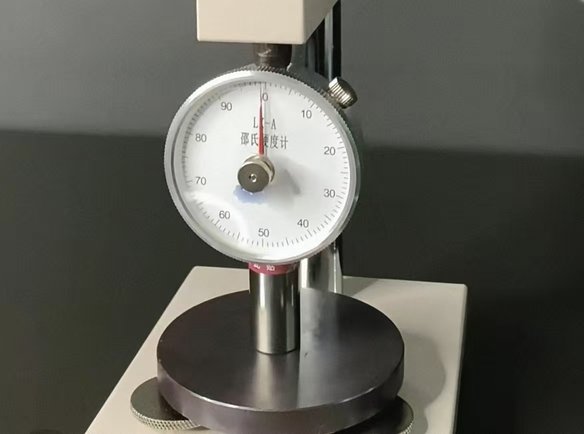Rubber hardness is a key factor in determining the durability, flexibility, and performance of rubber products. In this article, we’ll explore the various scales used to measure rubber hardness and why they matter for your applications.
The hardness scale for rubber is known as the "Shore A" scale, which ranges from 0 to 100, with 0 indicating the softest rubber and 100 the hardest, where lower numbers signify softer materials and higher numbers denote harder ones.
If you're dealing with rubber products, understanding hardness is crucial to making the right material choices. Let's break down how hardness is measured and why it matters.
What is Rubber Hardness?
Rubber hardness refers to the resistance of rubber to indentation or deformation when pressure is applied. It affects key properties like flexibility, strength, and wear resistance.
Rubber hardness is crucial in determining its flexibility and strength. A harder rubber will be less flexible, and vice versa.
The most common method for measuring rubber hardness is using a durometer. The durometer scale measures how deep a needle penetrates the rubber under a specific force. The deeper the penetration, the softer the material. Shore A scale1 and Shore D scale2 are the most widely used hardness scales for rubber.
Key Factors Affecting Rubber Hardness
- Material Type: Different rubber types have different hardness levels. For instance, synthetic rubbers often have different hardness characteristics than natural rubber.
- Additives: Fillers and additives like carbon black can affect the overall hardness of rubber.
- Temperature: Rubber hardness can change with temperature. Higher temperatures often make rubber softer, while cooler temperatures may increase hardness.
Common Rubber Hardness Scales
There are several scales used to measure rubber hardness, but the most widely used are the Shore A and Shore D scales.
The Shore A scale is the most common for softer rubbers, while the Shore D scale is used for harder materials.
Overview of the Shore Hardness Scale
The Shore hardness scale is a standardized method for quantifying the hardness of rubber and other flexible materials. It measures a material's resistance to indentation, which is crucial for assessing its performance in various applications.
Key Features of Shore Hardness Scales
-
Shore A Scale:
- Purpose: Used for softer rubbers and flexible materials.
- Range: Typically from 0A (very soft) to 100A (harder rubber).
- Common Applications: Rubber bands (30A), running shoe soles (70A), car tire treads (60A).
-
Shore D Scale:
- Purpose: Designed for harder rubbers and semi-rigid plastics.
- Range: Generally from 0D to 100D, with values above 90D indicating very hard materials.
- Common Applications: Industrial components and hard elastomers.
Comparison of Shore Hardness Scales
| Scale | Range | Common Applications |
|---|---|---|
| Shore A | 0A - 100A | Soft rubbers, TPEs, running shoe soles |
| Shore D | 0D - 100D | Harder rubbers, industrial components |
Measurement Method
The hardness is measured using a device called a durometer, which features a spring-loaded indenter. When the indenter is pressed into the rubber sample, the depth of indentation is measured. Each unit of indentation corresponds to a degree on the Shore scale. For example, every 0.001 inch of indentation equals one degree on the Shore A scale.
Why is the Shore A Scale Most Commonly Used for Rubber?
The Shore A scale is the most common hardness scale for rubber due to its versatility and ease of use. It is well-suited for measuring softer rubbers used in everyday products like tires, seals, and gaskets.
The Shore A scale is most commonly used because it covers a wide range of rubber types, from soft to medium hardness.
The Shore A scale provides a good balance between flexibility and durability, making it suitable for a variety of applications. It is particularly useful for products that need to maintain shape under pressure while offering some flexibility.
Why Choose Shore A for Your Rubber Products?
- Versatility: Can measure a wide range of rubber hardness, from soft to medium.
- Ease of Use: The Shore A durometer is easy to use and reliable for everyday measurements.
- Cost-effective: It’s the go-to method for many industries, from automotive to HVAC, making it affordable and widely available.
How Hard is a 60 Durometer?
A 60 durometer on the Shore A scale represents medium-hard rubber. This is a common hardness level used for products that need a balance of flexibility and durability, such as rubber seals, gaskets, and wheels.
A 60 durometer on the Shore A scale offers a good balance of durability and flexibility, making it ideal for various applications.
At 60 Shore A, the rubber is strong enough to resist wear and tear while maintaining enough flexibility to absorb impacts. It is often used in applications like:
- Seals: Ensures a tight seal while offering flexibility.
- Wheels: Balances durability with the ability to roll smoothly.
- Gaskets: Provides a durable yet flexible material for sealing joints.
Benefits of 60 Durometer Rubber
| Property | Benefit |
|---|---|
| Flexibility | Allows for some deformation |
| Durability | Resists wear and tear |
| Compression | Good at maintaining shape under pressure |
What is the ASTM Standard for Rubber Hardness?
The ASTM3 (American Society for Testing and Materials) has established the ASTM D2240 standard for testing rubber hardness. This standard outlines the procedure for measuring the hardness of rubber and elastomers using durometers.
The ASTM D2240 standard ensures consistency and accuracy when testing rubber hardness, making it the industry standard.
The ASTM D2240 standard specifies how to use durometers to measure rubber hardness, including the required testing conditions and equipment. This helps ensure that hardness measurements are consistent, reliable, and repeatable across different industries.
Key Elements of ASTM D2240
- Testing Method: Specifies the use of a durometer to measure rubber hardness.
- Conditions: Details the environment and conditions under which testing should occur.
- Consistency: Ensures that hardness measurements are standardized across industries.
Having standardized procedures like ASTM D2240 helps manufacturers maintain quality control and produce consistent rubber products.
Conclusion
Rubber hardness plays a crucial role in determining the suitability of materials for various applications. The Shore A scale is commonly used because it balances flexibility and durability, making it ideal for most rubber products.
Footnotes
-
The Shore A scale is widely used for softer rubbers and is a standard measurement in the rubber industry. ↩
-
The Shore D scale is used to measure harder rubber materials and plastics. ↩
-
ASTM D2240 is the standard test method used for measuring the hardness of rubber materials, ensuring consistency and accuracy in hardness measurements. ↩









